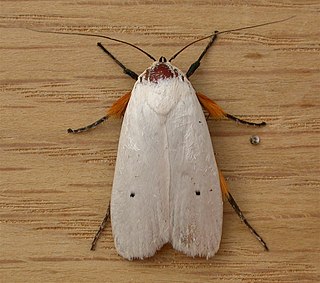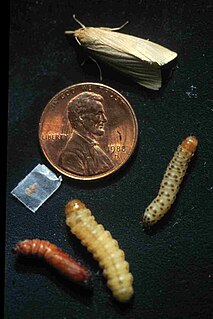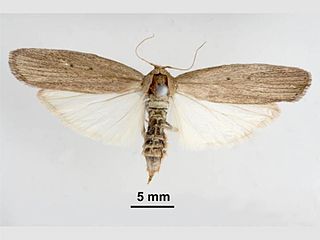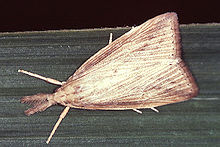
The Crambidae are the grass moth family of lepidopterans. They are variable in appearance, the nominal subfamily Crambinae taking up closely folded postures on grass stems where they are inconspicuous, while other subfamilies include brightly coloured and patterned insects which rest in wing-spread attitudes.

Manduca rustica, the rustic sphinx, is a moth of the family Sphingidae. The species was first described by Johan Christian Fabricius in 1775.

Perigonia lusca, the half-blind sphinx or coffee sphinx, is a moth of the family Sphingidae. It was first described by Johan Christian Fabricius in 1777.

Nephele hespera, the crepuscular hawkmoth, is a sphingid moth described by Johan Christian Fabricius in 1775.

The European corn borer, also known as the European corn worm or European high-flyer, is a moth of the family Crambidae which includes other grass moths. It is a pest of grain, particularly corn. The insect is native to Europe, originally infesting varieties of millet, including broom corn. The European corn borer was first reported in North America in 1917 in Massachusetts, but was probably introduced from Europe several years earlier. Since its initial discovery in the Americas, the insect has spread into Canada and westward across the United States to the Rocky Mountains.

Eumorpha satellitia, the satellite sphinx, is a moth of the family Sphingidae. The family was first described by Carl Linnaeus in 1771. It lives from Brazil and northern Argentina north through Central America, Mexico, and the West Indies to south Texas and southern Arizona.

The fruit tree borer is a moth of the family Xyloryctidae. It is native to Australia.

Deidamia inscriptum, the lettered sphinx, is a species of moth of the family Sphingidae. It is the only member of the genus Deidamia. The species was first described by Thaddeus William Harris in 1839 and the genus was erected by James Brackenridge Clemens in 1859.

Rhyzopertha is a monotypic genus of beetles in the family Bostrichidae, the false powderpost beetles. The sole species, Rhyzopertha dominica, is known commonly as the lesser grain borer, American wheat weevil, Australian wheat weevil, and stored grain borer. It is a beetle commonly found within store bought products and pest of stored cereal grains located worldwide. It is also a major pest of peanuts. The first documentation of wheat infestation by R. dominica was observed in Australia. R. dominica are usually reddish brown to dark brown in coloration, vary in sizes, elongated and cylindrical.

Anomis flava, the cotton looper, tropical anomis or white-pupiled scallop moth, is a moth of the family Erebidae. The species was first described by Johan Christian Fabricius in 1775. It is found in large parts of the world, including China, Hawaii, São Tomé and Príncipe, the Society Islands, Thailand, New Zealand, and Australia. Subspecies Anomis flava fimbriago is found in North America.

Thyas coronata is a species of moth of the family Noctuidae first described by Johan Christian Fabricius in 1775. It is found from the Indo-Australian tropics of southern China, Taiwan, Japan, Nepal, India, Sri Lanka to Micronesia and the Society Islands.

Achaea serva is a species of noctuid moth of the family Erebidae first described by Johan Christian Fabricius in 1775. It is found from the Indo-Australian tropics of India, Sri Lanka, Myanmar, China, Borneo, Hong Kong, Java, the Philippines, the New Hebrides, to Okinawa, many western Micronesian islands and New Guinea and Australia.

Pachylioides is a monotypic moth genus in the family Sphingidae erected by Ronald W. Hodges in 1971. Its only species, Pachylioides resumens, was first described by Francis Walker in 1856.

The southwestern corn borer, Diatraea grandiosella, is a moth belonging to the sub-order Heterocera. Like most moths, The southwestern corn borer undergoes complete metamorphosis developing as an egg, larva (caterpillar), pupa and adult. It is capable of entering diapause in its larva stage and under the conditions of a precise photoperiod. Growth and development are regulated by juvenile hormones. The southwestern corn borer has an extensive range. It occurs in Mexico and in Alabama, Arizona, Arkansas, Colorado, Illinois, Indiana, Kansas, Kentucky, Louisiana, Mississippi, Missouri, Nebraska, New Mexico, Oklahoma, Tennessee, and Texas.

Oraesia emarginata is a species of moth of the family Erebidae first described by Johan Christian Fabricius in 1794. It is found in Australia, New Caledonia, Indonesia, New Guinea, Pakistan, the Philippines, India, Sri Lanka, Sulawesi, Taiwan, China, Japan, Korea and Nepal as well as Eritrea, Ethiopia, Kenya, Namibia, Nigeria, South Africa, Tanzania, the Gambia, Uganda, Oman and Yemen.

Eldana is a genus of moths of the family Pyralidae containing only one species, the African sugar-cane borer, which is commonly found in Equatorial Guinea, Ghana, Mozambique, Sierra Leone and South Africa. Adults have pale brown forewings with two small spots in the centre and light brown hindwings, and they have a wingspan of 35mm. This species is particularly relevant to humans because the larvae are a pest of the Saccharum species as well as several grain crops such as sorghum and maize. Other recorded host plants are cassava, rice and Cyperus species. When attacking these crops, E. saccharina bores into the stems of their host plant, causing severe damage to the crop. This behavior is the origin of the E. saccharrina's common name, the African sugar-cane borer. The African sugar-cane borer is a resilient pest, as it can survive crop burnings. Other methods such as intercropping and parasitic wasps have been employed to prevent further damage to crops.

Diatraea crambidoides, the southern cornstalk borer moth, is a species of moth of the family Crambidae described by Augustus Radcliffe Grote in 1880. It is found in North America, from Alabama and northern Florida to Ohio and Maryland. Its wingspan is 15–40 mm, and adults are straw colored to dull white. The forewings are slightly darker than the hindwings. There are two generations per year.

Ostrinia furnacalis is a species of moth in the family Crambidae, the grass moths. It was described by Achille Guenée in 1854 and is known by the common name Asian corn borer since this species is found in Asia and feeds mainly on corn crop. The moth is found from China to Australia, including in Java, Sulawesi, the Philippines, Borneo, New Guinea, the Solomon Islands, and Micronesia. The Asian corn borer is part of the species complex, Ostrinia, in which members are difficult to distinguish based on appearance. Other Ostrinia such as O. orientalis, O. scapulalis, O. zealis, and O. zaguliaevi can occur with O. furnacalis, and the taxa can be hard to tell apart.
Scirpophaga nivella is a moth in the family Crambidae. It was described by Johan Christian Fabricius in 1794. It is found in southern Asia from the Indian Subcontinent in the west to southern China in the east, south to New Guinea and Australia, including New Caledonia and Fiji. Some sources have affixed the common name "sugarcane top borer" to it, despite it not being found in sugarcane, because they are confused with the species Scirpophaga excerptalis, which is an actual borer in the tops of sugarcane. Another newer common name that has been invented for these moths is "white rice borer".






















